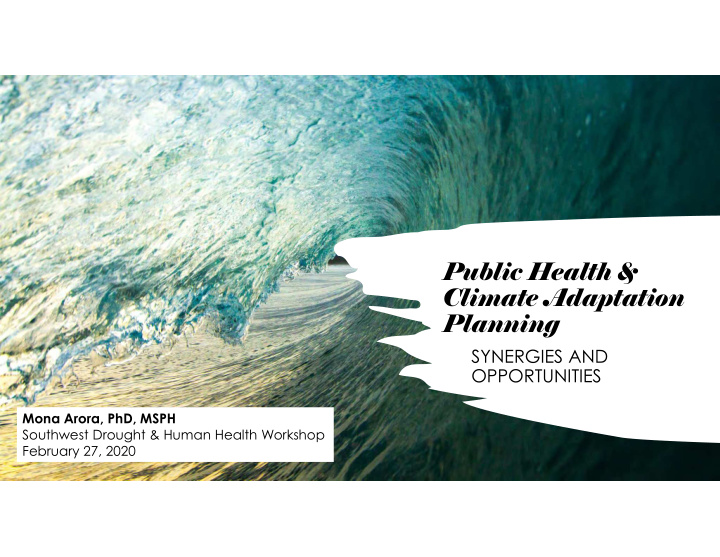



Public Health & Climate Adaptation Planning SYNERGIES AND OPPORTUNITIES Mona Arora, PhD, MSPH Southwest Drought & Human Health Workshop February 27, 2020
Illustrate how the public health system engages with climate change adaptation. Objectives Provide insights to bring together public health and climate science.
What does public health engagement on climate change look like? • Plans? • Assessments? • Epidemiologic studies?
National Survey 4
“I also think too, internally, I think there are sectors or organizations or even just different staff that don't necessarily see that connection between what they do and climate change.”
What is public health engagement actually look like?
40% 35% Percentage of Respondents 35% 30% 25% 23% 20% 17% 15% 15% 11% 10% 5% 0% YES NO, But similar NO Plans In Development Don't plan know/unsure Climate & Health Strategic Planning
Climate Change Activities Funded Not funded Unsure Policies & Plans 80% Researching Linking to services 70% 60% 50% 40% EWS development Forming partnerships 30% 20% 10% 0% Tracking trends Conducting assessments Investigating Training Informing policymakers Informing public 8
Barriers Lack of institutional support. 28% 21% 16% 35% Lack of staff. 8% 16% 29% 47% Lack of funding. 5% 17% 24% 55% Timeliness of receiving information. 25% 31% 37% 7% Lack of required long-term health outcome data. 17% 26% 35% 22% Lack of hardware to acquire data. 47% 17% 21% 12% Lack of software to handle the data. 46% 19% 22% 13% Limited training and expertise to work with data. 26% 28% 26% 19% Not enough examples or models for use at local level. 24% 27% 37% 12% The current projections are difficult to understand. 35% 40% 19% 7% Projections are too uncertain. 19% 37% 33% 11% Spatial scale is too coarse. 19% 42% 29% 10% Temporal scale is too long. 20% 36% 34% 10% 0% 10% 20% 30% 40% 50% 60% 70% 80% 90% 100% Not a Barrier Somewhat of a Barrier Moderate Barrier Extreme Barrier
How can climate science and public health come together?
11 Adapted from: Shumake-Guillemot, J., & Fernandez-Montoya, L. (2016).
Solution 1: Enabling Environment Local and Regional forums Build partnerships Multi-disciplinary Aligning interests meetings Data & knowledge sharing Communication & Climate vs. Health Inform research Collaboration reports Prioritizing actions Inform decisions Focused workshops “The reports seemed to be created by epis (epidemiologists) for epis. As a program manager, I didn’t have a strong epi or biostatistics background so synthesizing the information was more challenging.” Incentivizing Engagement
Solution 2: Building Public Health Capacity
Public Health Framing • Common ground: value added benefits to community and wellbeing • Community level benefits that begin with a focus on the most vulnerable and expand • Social Determinants of Health, Health Equity • Be actionable: provide solutions that are time and place oriented. • Integrate specific language • Promote tailored, salient, culturally relevant actions
Action Items • Is public health at the table? • Has the process, output, or report been vetted by public health? • Are health impacts explicitly addressed? • Is the health connection apparent? • Can you add climate and health messaging? • Are there existing frames that your work or ask can align to?
Recommend
More recommend